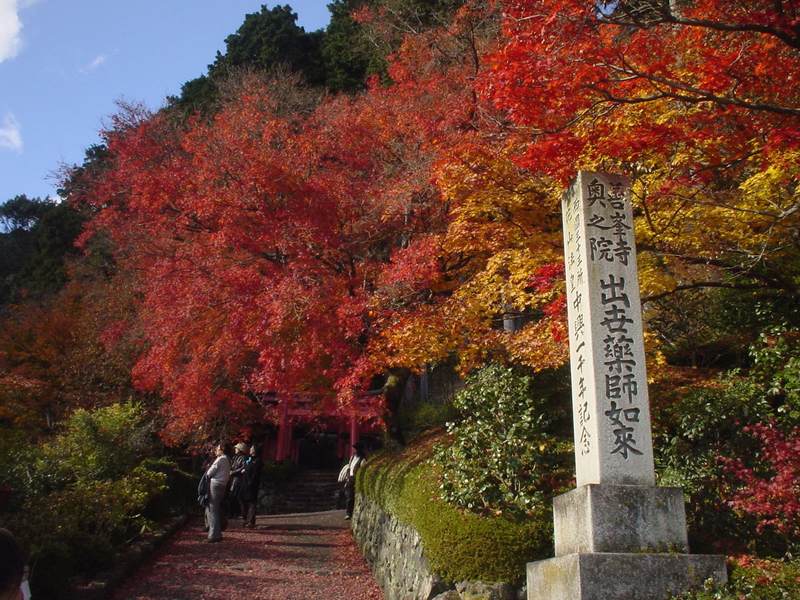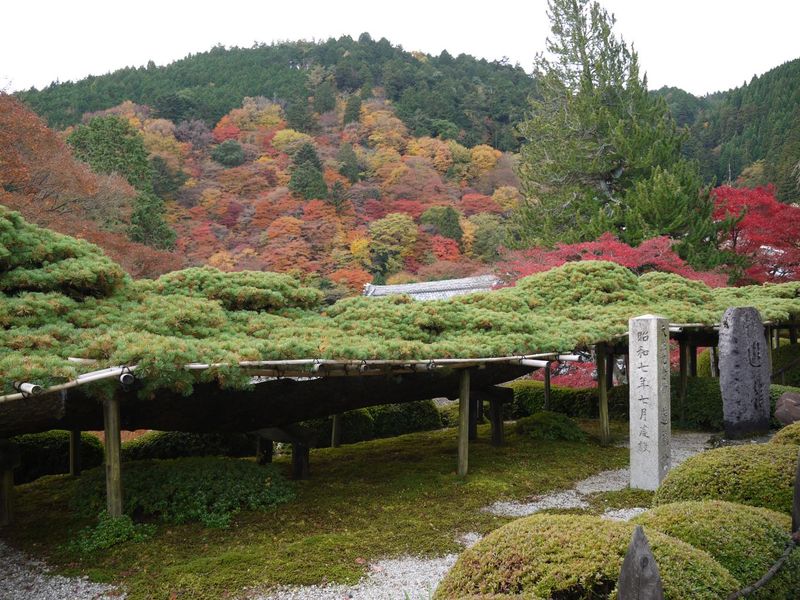Oharano, Kyoto
Oharano is a large agricultural area south-west of Kyoto, in the valley of Mount Oshio.
It is one of the less known areas of Kyoto among tourists and it's often omitted by the guidebooks. Do not confuse this area with the village of
Ohara.
The neighborhood
In this area you can visit some Buddhist temples and Shinto shrines, for the rest there are only fields and small houses.
Yoshiminedera Temple
(admission 500 yen, opening hours 8-17)
The most important temple in the area, belonging to the Tendai sect of Buddhism, it was founded in 1029 by a monk called Gesan.
It is one of the furthest, it is located outside the built-up area, in the middle of a forest on the slopes of Mount Oshio, from which one can see in the distance the city of Kyoto, especially going up along the paths inside the temple.
There is one of the oldest pine trees in Japan, which seems to have about 600 years, it is called
Yōryu no matsu ("Gliding Dragon") because of its very curious horizontal shape.
This temple, rarely visited during the year, becomes very popular in spring and autumn because of the lush vegetation that surrounds it.
Sankoji Temple
A small temple, virtually unknown, nothing special to point out.
It is also nestled in the woods on the slopes of Mount Oshio, about 200-300 meters above the Temple Yoshiminedera. If you go to visit the Yoshiminedera, maybe you could also take a walk along the path leading to this temple before going back to the city.

 beautiful autumn colors in the forest on Mount Oshio - on the right, the particular pine Yōryu no matsu inside the Temple Yoshiminedera
beautiful autumn colors in the forest on Mount Oshio - on the right, the particular pine Yōryu no matsu inside the Temple Yoshiminedera
Jurinji Temple
(admission 400 yen, opening hours 9-17)
This temple is located along the road towards the Yoshimidera, 1.8 km to the east.
It was founded in 850 for the Emperor's wife, so that she could be able to give birth to a son, and shortly after it happened. For this reason, some couples waiting to have a child still visit this temple to pray.
Until the year 880 it was the home of the poet
Ariwara Narihira (author of the poem
Ise Monogatari), for this reason it is also called
Narihira-dera. On the back of the temple there is a furnace that is said to have been used by Narihira.
Inside there are two small gardens, one on the front, a normal garden that surrounds a small pond, another on the back, decorated with rocks and pebbles in order to represent a sea bed, behind which there is also a very old cherry tree called
Narihira-zakura.
 the old cherry tree inside the Temple Jurinji
the old cherry tree inside the Temple Jurinji
Shojiji Temple
(admission 400 yen, opening hours 9-17)
Founded back in the year 686, this temple is also called Hanadera, which means "temple of the flowers." Its gardens were for a time the home of the poet
Saigyo, who lived in the twelfth century.
It is surrounded by several cherry, plum and maple trees. During the flowering period in April or in the fall, it could be an original alternative to admire the spectacle of hanami or of the autumn colors in a quiet and not crowded place. Very few tourists visit this temple, partly because of its remote location.
Shoboji Temple
(admission 400 yen, opening hours 9-17)
Temple pretty much out of any sightseeing tour, if you're in the area you could shortly take a look at it, it's located a few meters from the Shojiji and the Oharano Shrine.
I point out its gardens, including a rock garden designed in harmony with the mountains in the background, which should be a "piece" of the design of this garden.
 the rock garden of the Temple Shoboji
the rock garden of the Temple Shoboji
Oharano Shrine
(free admission)
A Shinto shrine established in 1784, surrounded by a dense forest. Charming atmosphere, like all Shinto shrines nestled among the trees, nothing special to report. It worths a visit only if you are in the area.
Sleeping in Oharano
An area away from any other place of interest Kyoto and not served by any station, not suitable for staying.
Pratical guide, how to get to Oharano
The main problem of Oharano, which makes it a rarely visited area in Kyoto, is that it is a very large area but difficult to be reached, and it isn't served by any railway station.
Two stations are relatively nearby:
Mukomachi station (
JR Kyoto Line) and
Higashimuko Station (
Hankyu Kyoto Line).
From both these stations you can take bus number #66 of
Hankyu Bus company, stopping first near the Jurinji and subsequently arrives at the Yoshiminedera.
For the temples Shojiji, Shoboji and the Oharano shrine you can take the bus number #63 or #65 and get off at the bus stop called
Minamikasuga (南春日町), that is the closest to these temples but still about 1/1.2 km away.
But be careful because these lines have very few daily frequencies and irregular intervals, and on the internet you cannot find any information in English. If you don't have any particular problem of budget, I suggest you to take a taxi (about 1500/2000 yen).
Map of Oharano, Kyoto
Guided tours, activities and other things to do
If you are planning a trip to Japan and you want to do something more than just visiting famous places and monuments, we suggest you to use
Rakuten Travel Experiences.
How to use Rakuten Travel Experiences
Rakuten Travel is a very useful website to
enrich your travel experience, especially if you are going solo or it's your first time in Japan.
Because of the language barrier (and more), in Japan it is very difficult to interact with the locals and to get off the tourist track.
Thanks to Rakuten Travel you can find a lot of interesting and sometimes unique
guided tours and activities all over Japan (and not only in Japan), that you would otherwise never be able to enjoy.
But there's more: on Rakuten Travel you can also
buy tickets for several famous attractions, events, transportation and other useful services for tourists. Last but not least, you can
reserve a table in hundreds of restaurants.
Some examples
Take a look at Rakuten Travel Experiences
You may also be interested in

 beautiful autumn colors in the forest on Mount Oshio - on the right, the particular pine Yōryu no matsu inside the Temple Yoshiminedera
beautiful autumn colors in the forest on Mount Oshio - on the right, the particular pine Yōryu no matsu inside the Temple Yoshiminedera